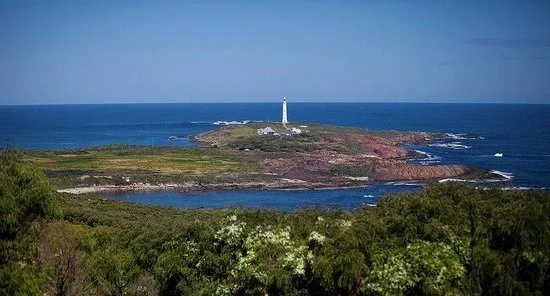In 2016 I was walking the Cape to Cape track in Western Australia. It goes from one lighthouse to another, but not in a straight line. It's a windy trail which lets you see the Cape Leeuwin lighthouse, but if you've never been on the path before, you don't know exactly what it's going to take to get there. You can see what the end goal could look like, but the only sure thing is that you can't take a straight line across the bay.
The “Vision, Mission and Values” Trap
Many businesses I come across, especially here in Australia, have vision and mission statements. “That’s impressive”, you may say. Until you conclude that many of the senior leadership don’t know why they have them. What is more, there seems massive confusion between the terms. Often some clever consultant has come in and facilitated a strategy workshop; thrown in a few “Values” for good measure, usually quoting Jim Collins and “Good to Great” along the way.
Is it any coincidence that so many organisations struggle with the concept of CEO accountability? Short term financials are a very poor proxy for what a CEO is charged to do. Financials are easy to measure and even long term financial performance is very narrow in its context.
I do see some great organisations with powerful statements of intent. I just don’t get how these are joined-up with their operational plans. You would hope especially that in the Not for Profit sector organisations would have a clear Purpose, usually enshrined in their mission statement. You would hope........ in my experience these are often very broad statements intentionally designed to allow an organisation lots of wriggle room to expand into areas outside their original remit. In the commercial world, often the founder’s purpose has been lost to be replaced by a generic feel good statement of meeting customers’ needs.
But if the purpose isn’t clear, the destination is even fuzzier. Jim Collins introduced the concept of the “BHAG “ – The “Big, Hairy, Audacious Goal” and described very clearly how it could be used to align a joined-up strategy. Most businesses have forgotten how to fully utilize this. Not for Profits seem uncomfortable with setting a specific objective, often because of the social challenges facing the sector and the understandable difficulties in defining "Impact". Commercial organisations fall into the trap of setting financial objectives without teasing out the underlying story behind the numbers.
Peter Drucker said:
“Whenever you see a successful business, someone once made a courageous decision”
Behind that statement is usually a story about a founder that had identified a need that their organisation could fulfil; some call that Vision, but often in start-up situations its very hard to define a Vision or a BHAG with a longer time horizon. What is clear is that very few businesses that have gone beyond start-up have succeeded without getting much clearer about the longer-term destination. Once the organisation grows beyond just being in the control of the founder the initial focus and drive is in danger of being lost. It usually starts by everyone in the senior team having a broadly aligned idea but then gets diluted, sometimes by new opportunities, often by different perceptions of urgency and timescale and different views on risk and risk appetite.
Add to this, we are looking at a world where disruption of business models and technologies provide an environment of increasing Volatility, Uncertainty, Complexity and Ambiguity (VUCA) and the path ahead is less clear. Some CEO’s, recognising this, feel it is pointless to have a long term plan at all. What this leads to however is the need to make strategic decisions from the ground up all the time; a need to keep tight controls and a forcing of strategic decisions up the tree, leaving only tactical and operational decisions within the organisation. This is not exactly motivational for the executive team and the layer below them.
There is a middle way between having a rigid multi-year plan and an ad hoc strategy decision making process. Its by identifying the Lighthouse.
Making joined-up decisions in a VUCA world
One of the issues facing all organisations in a VUCA world is the need to make strategic decisions much faster.
What if we could have a simple model that allowed not only the CEO and the Board to quickly assess strategic decisions, but also the entire leadership community? How much time could be saved in constant discussions over well-meaning proposals when everybody has an opinion? What if other factors were able to be considered, when pure financial return analysis doesn’t feel adequate? (and does it ever?)
I know several CEOs who are considering geographical expansion and some broadening of their service offering. While any decision of this substance and strategic importance will always need to answer the questions of “does the potential reward / return justify the risk / investment?” and “can we afford it in terms of financial, human and leadership resources?”, I remind the CEOs that they should only consider opportunities that answer two more fundamental questions first:
- Does it fit with the Purpose?
- Does help us get closer to the Lighthouse destination?
Discussion on Purpose is for another day. I will focus simply on the Lighthouse concept, the destination. Jim Collins said in an article entitled “The Good to Great Pastor”:
“You must ask, "What do we mean by great results?" Your goals don't have to be quantifiable, but they do have to be describable. Some leaders try to insist, "The only acceptable goals are measurable," but that's actually an undisciplined statement. Lots of goals—beauty, quality, life change, love—are worthy but not quantifiable. But you do have to be able to tell if you're making progress."
A Lighthouse destination needs an emotional context
The Lighthouse is the organisation’s destination – where it is going. As Jim Collins so eloquently describes, it must be describable – you must be able to tell if you are making progress. A Lighthouse for an organisation might be called a “Key Milestone”, a Vision, an Ambition, a BHAG, but the label doesn’t matter, its what you use it for that counts.
At its heart, the Lighthouse will most likely be a statement that's based in emotion, not just numbers. Let’s say a really ambitious target is to triple sales over the next five years. Why is that important to you? How will employees feel about that? What will customers feel about that? Then translate those emotional responses into describing the lighthouse in a way that captures these emotions.
It is in development of the Lighthouse that emotions can and should be unleashed. That is because any chosen destination should stimulate the discussion around “If we really, truly mean this, then what are the implications?” It challenges the status quo, it fleshes out all around a central theme the implications in terms of resources, culture change, market reach and other critical factors that will be needed to ensure success. It’s also a sanity check that should stimulate passion and emotions including surfacing of doubts and fears which need to be addressed rather than suppressed.
The Lighthouse looks and feels like a “Winning Aspiration” (another label) as described in the book “Playing to Win”. It becomes the CEO’s soundtrack – often introduced by a story about an individual impacted by the organisation achieving its destination, but then fleshed out by the implications. It is not a single statement but a series of implications from a central theme. Success is always defined by the outside world recognising the achievement of the organisation, a stakeholder view of the destination.
“Clarity creates Confidence, Confusion causes Chaos” Greg Bustin, Vistage Chair and Accountability author
Having a clear destination is a fundamental building block in ensuring a whole organisation has an accountable structure.
Without it, all roads look the same, executives can interpret a destination for their own purposes. Without it a board continues to ask questions when they should be letting the CEO develop and implement a plan to reach the destination.
What does a Lighthouse session look like?
1. Involve the board and a strategically competent executive team; but don’t design by a committee. The CEO must be the primary owner.
Often it is argued that the board determines strategy; in practice it is the organisation’s leader that has to be the architect of the direction. This can be within the remit of the organisation’s purpose and constitution which can be safeguarded by a board and the board has a final sign-off but nobody can replace the full time senior executive officer in owning this.
2. Use an outside facilitator. (Of course I’d say this..)
Emotions need to be tapped, consequences fleshed out. Outside-In impact needs to be considered. It is impossible for the CEO to facilitate this discussion; they need their opinions to count so they are not best suited for the process. Similarly, the board needs to be actively engaged in the content not just process for this part of their role. A good facilitator will ensure there is adequate challenge to ensure clarity is there for those outside the meeting.
3. Keep the Lighthouse session separate from planning.
This phase is clearly part of the Strategy Development phase. In an increasingly uncertain world, this needs a degree of opening up and “outside the box” discussions. Planning on the other hand is a focusing and narrowing process requiring very different dynamics. This should follow a few weeks after the Lighthouse session.
4. Assume this is where you are heading but do allow in the regular review process for a change of destination if conditions significantly change.
With a clear destination in place, paradoxically, an organisation can change the direction and then identify the consequences of that change. Nothing is cast in stone, but clarity effects every single decision made in the organisation. This way an organisation can “pivot” very quickly if it has to.
I'd be interested to hear of others' experiences and journeys and if you have other suggestions to the basic elements I've outlined here.










